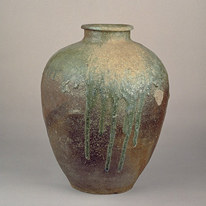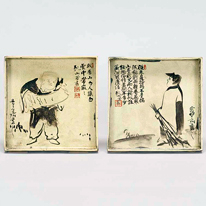Past Exhibitions
- Japanese Ceramics from Medieval Kilns
- June 21, 2016 - October 2, 2016
Ceramics have been used since ancient times to make the functional vessels needed for daily life, including large jars to hold water and grains, and bowls, plates, and and other dishes for serving food. In medieval Japan, from the Kamakura (1185–1333) through the Muromachi (1392–1573) periods, there were six kilns around the country particularly well known for producing such everyday ceramics: Seto, Tokoname, Shigaraki, Tanba, Bizen, and Echizen. Today these are known as the Six Early Kilns. Their wares tend to be simple and rustic in flavor, but they can also exude a powerful sense of natural beauty achieved through the meeting of clay and fire. Over time, with increased research on these early kilns, their once humble wares have become sought after by museums and collectors as works of high art. Some outstanding examples are on view in this exhibition.
- Ceramics of Japan and East Asia
- June 21, 2016 - October 2, 2016
Traditionally, ceramics has been an applied art, not only for viewing but also used as dishware or everyday furnishings, and is a familiar part of our surroundings. Ceramics produced in East Asia in particular vary widely in terms of pattern, form, and color, and are used for an extraordinarily wide range of applications. Works from different production sites are made with different materials, such as earthenware or porcelain, and have strongly distinct character depending on the variety of clay, glaze materials, ornamentation, firing technique and so forth. Here we present a variety of ceramics primarily from Japan, China, and the Korean Peninsula, along with explanations of their distinctive qualities and unique appeal.













